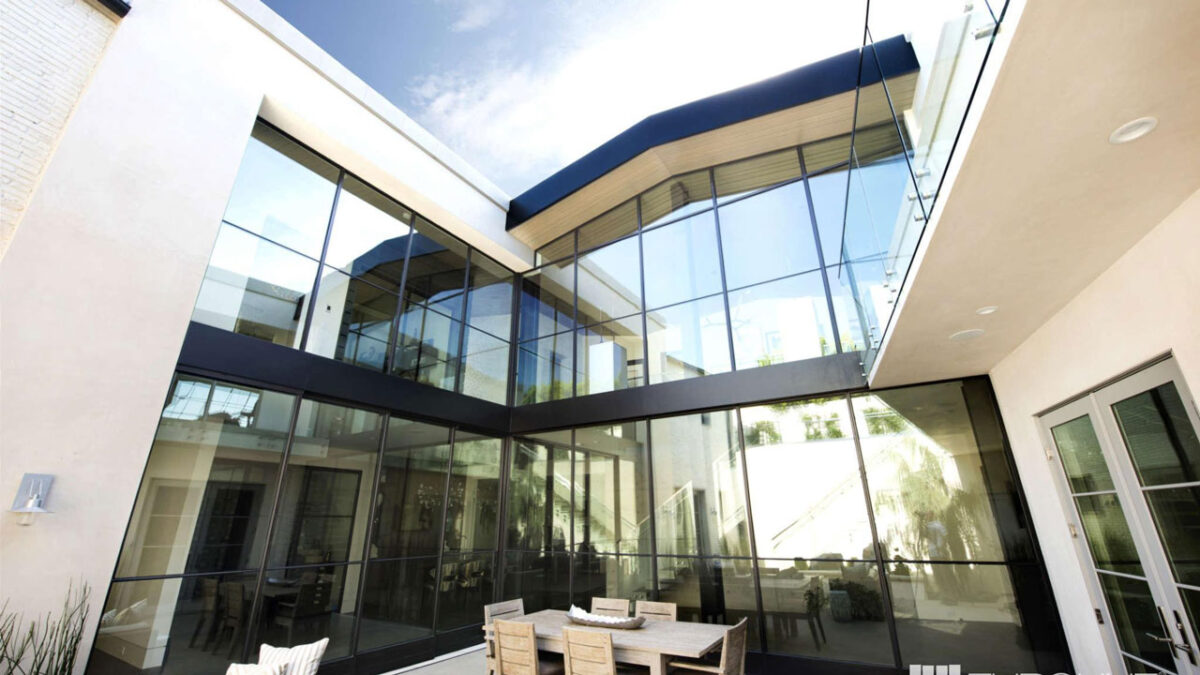In the realm of modern building designs, curtain wall systems have emerged as a popular choice for both high-rise buildings and low-rise structures, thanks to their ability to enhance natural light, aesthetic appeal, and energy efficiency. Choosing the right curtain wall and picture window system can significantly impact the building’s appearance, performance, and maintenance requirements.
In this guide, we aim to help building owners and architects navigate the various options and select the ideal curtain wall system for their building project.
Types of Curtain Wall Systems
A curtain wall acts as the outer layer of a building, serving as a non-structural cladding system that does not bear any dead loads from the building but is crucial in managing environmental conditions. Comprising aluminum frames filled with glass units, opaque panels, or both, curtain wall systems are designed to protect the building envelope while allowing for expansive views and natural light penetration, often referred to as the “picture wall” effect.
There are common types of curtain wall systems, each offering a different level of performance, installation process, and maintenance requirements:
- Stick-built Curtain Wall Systems: Assembled piece by piece on-site, these systems offer high customization but require higher labor costs and longer installation times. They are ideal choices for unique building façades that face complex environmental conditions.
- Unitized Curtain Wall Systems: These consist of prefabricated units that are assembled in the factory and installed as single panels on the building. Unitized systems are known for their quicker installation process and are often used in high-rise buildings due to their excellent weather resistance and energy efficiency.
- Aluminum Curtain Wall Systems: Featuring aluminum frames, these systems provide a combination of strength, thermal efficiency, and aesthetic appeal. They can accommodate a wide variety of glass panels, including high-performance glass and laminated glass, to enhance thermal performance and safety.
Factors to Consider When Choosing a Curtain Wall System
Building Structure and Height
The choice between unitized systems and stick-built systems can depend on the building’s height and structural frame. High-rise and commercial buildings may benefit more from unitized curtain wall systems due to their wind loads resistance and ease of installation at great heights, whereas low-rise buildings might opt for stick-built or aluminum curtain wall systems for their versatility and cost-effectiveness.
Thermal Performance and Energy Efficiency
Evaluate the thermal performance needs of your building. High-performance glass and thermal breaks should be considered to reduce energy consumption and improve the building’s overall energy efficiency. Look for systems that support excellent energy efficiency to comply with building codes and reduce long-term energy costs.
Aesthetic Appeal
The aesthetic appeal of curtain wall systems is crucial in modern building designs. Consider the visual impact of different systems and how they align with the architectural design of your building façade. A wide variety of glass panels, colors, and finishes are available to match the desired exterior cladding look.
Weather Resistance and Maintenance
Assess the environmental conditions your building will face, including wind loads, water infiltration, and temperature variations. Choose a system with adequate weather resistance and proper water management features like pressure plates and water drainage systems, and consider the ease of regular maintenance and repair.
Budget and Installation Costs
Curtain wall systems vary widely in price, influenced by the types of curtain wall chosen, the complexity of the design, and the materials used. Balance your aesthetic and performance requirements with the available budget, and consider both initial installation costs and long-term maintenance expenses.
Curtain Wall System Uses and Applications
Curtain wall systems, known for their aesthetic appeal and functional benefits, are employed in various architectural projects worldwide. These non-structural cladding systems are designed to protect the building from external weather elements while providing abundant natural light and visual appeal. Below are some of the primary uses and applications of curtain wall systems:
1. Office Buildings
Curtain wall systems are extensively used in office buildings to create a modern, prestigious appearance while offering employees panoramic views and ample natural light. This can enhance worker productivity and satisfaction. The energy-efficient properties of curtain walls also help reduce heating and cooling costs, contributing to a more sustainable and cost-effective building operation.
2. High-rise Residential Buildings
In high-rise residential complexes, curtain wall systems provide residents with unobstructed views and natural lighting, contributing to the quality of living spaces. They also add a sleek, contemporary look to the building’s exterior, enhancing its curb appeal and potentially increasing property values.
3. Commercial Retail Spaces
Curtain walls are popular in commercial retail spaces, such as shopping malls and storefronts, where maximum visibility is desired. They allow potential customers to see inside the space from the outside, creating an inviting atmosphere and showcasing products or interiors. Curtain walls can also contribute to the branding and image of retail businesses.
4. Educational Facilities
Schools, universities, and other educational facilities often use curtain wall systems to achieve bright, welcoming environments conducive to learning. The natural light that permeates through the curtain walls helps create a pleasant and stimulating atmosphere for students and faculty alike.
5. Healthcare Facilities
Hospitals and healthcare facilities utilize curtain wall systems to foster environments filled with natural light, which can aid in patient recovery and well-being. Curtain walls also help create a sense of openness and connectivity with the outside world, which is beneficial for patients and healthcare workers.
Selecting the right curtain wall system is a critical decision in the construction or renovation of a building. By considering factors such as building structure, energy efficiency, aesthetic preferences, weather resistance, and cost, building owners can ensure their curtain wall enhances the building’s natural light, energy efficiency, and exterior aesthetics while meeting performance standards.
Transform Your Building with Euroline Steel Windows
Upgrade your commercial or residential project with Euroline Steel Windows. Our windows complement any curtain wall system, offering unmatched durability, style, and thermal efficiency. Contact Euroline Steel Windows today to enhance the energy efficiency and aesthetic appeal of your building.


